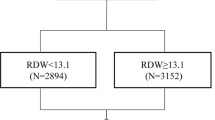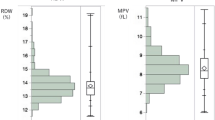Abstract
Red cell distribution width (RDW), a measure of the variability in size of circulating erythrocytes, is an independent predictor of mortality in patients with cardiovascular disease. We hypothesized that RDW is a prognostic marker of death, myocardial infarction and unplanned revascularization in a broad population undergoing percutaneous coronary intervention (PCI). We investigated the prognostic value of RDW derived from a complete blood count drawn ≤24 h of PCI in 1,689 patients at four centers who underwent PCI between 2004 and 2007 in the evaluation of drug eluting stents and ischemic events registry. Patients who underwent blood transfusions were excluded. Multivariable analyses of death, MI, unplanned revascularization, and the combined occurrence of these events at 1 year were performed using methods from survival analysis. The analysis was adjusted for creatinine ≥1.5 mg/dL, hemoglobin, congestive heart failure, coronary artery bypass grafting history, male sex, BMI, atherosclerosis of ≥2 coronary vessels, and hypertension. In univariate analysis of RDW stratified by quartiles, membership in the highest quartile was a predictor of mortality as compared to the lowest quartile (HR 5.07, CI 2.07–12.40, p < 0.001). In multivariate analysis, RDW was not an independent predictor of unplanned revascularization after PCI; however, RDW remained an independent correlate of 1 year mortality (HR 1.65, CI 1.22–2.23, p = 0.001); with a continuous net reclassification improvement of 46.5 % (95 % CI 15.1–76.4 %) and a relative integrated discrimination improvement of 57.8 % (95 % CI 22.1–94.9 %) after PCI. RDW is a widely available independent correlate of 1-year mortality after PCI that increases the discriminative value of risk prediction in these patients.


Similar content being viewed by others
References
Zalawadiya SK, Veeranna V, Niraj A, Pradhan J, Afonso L (2010) Red cell distribution width and risk of coronary heart disease events. Am J Cardiol 106(7):988–993
Patel KV, Ferrucci L, Ershler WB, Longo DL, Guralnik JM (2009) Red blood cell distribution width and the risk of death in middle-aged and older adults. Arch Intern Med 169(5):515–523
Perlstein TS, Weuve J, Pfeffer MA, Beckman JA (2009) Red blood cell distribution width and mortality risk in a community-based prospective cohort. Arch Intern Med 169(6):588–594
Poludasu S, Marmur JD, Weedon J, Khan W, Cavusoglu E (2009) Red cell distribution width (RDW) as a predictor of long-term mortality in patients undergoing percutaneous coronary intervention. Thromb Haemost 102(3):581–587
Jacob S, Cohen DJ, Massaro J, Niemyski P, Maresh K, Kleiman N (2005) Design of a registry to characterize “real-world” outcomes of percutaneous coronary revascularization in the drug-eluting stent era. Am Heart J 150(5):887–892
Win HK, Caldera AE, Maresh K et al (2007) Clinical outcomes and stent thrombosis following off-label use of drug-eluting stents. JAMA 297(18):2001–2009
Cuzick J (1985) A Wilcoxon-type test for trend. Stat Med 4(1):87–90
Pencina MJ, D’Agostino RB, D’Agostino RB Sr, Vasan RS Jr (2008) Evaluating the added predictive ability of a new marker: from area under the ROC curve to reclassification and beyond. Stat Med 27(2):157–172 discussion 207–12
Pencina MJ, D’Agostino RB Sr, Steyerberg EW (2011) Extensions of net reclassification improvement calculations to measure usefulness of new biomarkers. Stat Med 30(1):11–21
Pencina MJ, D’Agostino RB Sr, Demler OV (2012) Novel metrics for evaluating improvement in discrimination: net reclassification and integrated discrimination improvement for normal variables and nested models. Stat Med 31:101–113
Allen LA, Felker GM, Mehra MR et al (2010) Validation and potential mechanisms of red cell distribution width as a prognostic marker in heart failure. J Card Fail 16(3):230–238
Felker GM, Allen LA, Pocock SJ et al (2007) Red cell distribution width as a novel prognostic marker in heart failure: data from the CHARM Program and the Duke databank. J Am Coll Cardiol 50(1):40–47
van Kimmenade RR, Mohammed AA, Uthamalingam S, van der Meer P, Felker GM, Januzzi JL Jr (2010) Red blood cell distribution width and 1-year mortality in acute heart failure. Eur J Heart Fail 12(2):129–136
Tonelli M, Sacks F, Arnold M, Moye L, Davis B, Pfeffer M (2008) Relation between red blood cell distribution width and cardiovascular event rate in people with coronary disease. Circulation 117(2):163–168
Ani C, Ovbiagele B (2009) Elevated red blood cell distribution width predicts mortality in persons with known stroke. J Neurol Sci 277(1–2):103–108
Cavusoglu E, Chopra V, Gupta A et al (2010) Relation between red blood cell distribution width (RDW) and all-cause mortality at 2 years in an unselected population referred for coronary angiography. Int J Cardiol 141(2):141–146
Dabbah S, Hammerman H, Markiewicz W, Aronson D (2010) Relation between red cell distribution width and clinical outcomes after acute myocardial infarction. Am J Cardiol 105(3):312–317
Lippi G, Targher G, Montagnana M, Salvagno GL, Zoppini G, Guidi GC (2009) Relation between red blood cell distribution width and inflammatory biomarkers in a large cohort of unselected outpatients. Arch Pathol Lab Med 133(4):628–632
Forhecz Z, Gombos T, Borgulya G, Pozsonyi Z, Prohaszka Z, Janoskuti L (2009) Red cell distribution width in heart failure: prediction of clinical events and relationship with markers of ineffective erythropoiesis, inflammation, renal function, and nutritional state. Am Heart J 158(4):659–666
Ghaffari S (2008) Oxidative stress in the regulation of normal and neoplastic hematopoiesis. Antioxid Redox Signal 10(11):1923–1940
Wen Y (2010) High red blood cell distribution width is closely associated with risk of carotid artery atherosclerosis in patients with hypertension. Exp Clin Cardiol 15(3):37–40
de Sauvage FJ, Hass PE, Spencer SD et al (1994) Stimulation of megakaryocytopoiesis and thrombopoiesis by the c-Mpl ligand. Nature 369(6481):533–538
Stohlawetz PJ, Dzirlo L, Hergovich N et al (2000) Effects of erythropoietin on platelet reactivity and thrombopoiesis in humans. Blood 95(9):2983–2989
Guthikonda S, Alviar CL, Vaduganathan M et al (2008) Role of reticulated platelets and platelet size heterogeneity on platelet activity after dual antiplatelet therapy with aspirin and clopidogrel in patients with stable coronary artery disease. J Am Coll Cardiol 52(9):743–749
Arbustini E (2007) Total erythrocyte membrane cholesterol: an innocent new marker or an active player in acute coronary syndromes? J Am Coll Cardiol 49(21):2090–2092
Kolodgie FD, Gold HK, Burke AP et al (2003) Intraplaque hemorrhage and progression of coronary atheroma. N Engl J Med 349(24):2316–2325
Pasterkamp G, Virmani R (2002) The erythrocyte: a new player in atheromatous core formation. Heart 88(2):115–116
Sun Q, Ma J, Campos H et al (2007) A prospective study of trans fatty acids in erythrocytes and risk of coronary heart disease. Circulation 115(14):1858–1865
Turitto VT, Weiss HJ (1980) Red blood cells: their dual role in thrombus formation. Science 207(4430):541–543
Tziakas DN, Kaski JC, Chalikias GK et al (2007) Total cholesterol content of erythrocyte membranes is increased in patients with acute coronary syndrome: a new marker of clinical instability? J Am Coll Cardiol 49(21):2081–2089
Author information
Authors and Affiliations
Corresponding author
Rights and permissions
About this article
Cite this article
Fatemi, O., Paranilam, J., Rainow, A. et al. Red cell distribution width is a predictor of mortality in patients undergoing percutaneous coronary intervention. J Thromb Thrombolysis 35, 57–64 (2013). https://doi.org/10.1007/s11239-012-0767-x
Published:
Issue Date:
DOI: https://doi.org/10.1007/s11239-012-0767-x




